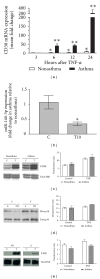Altered CD38/Cyclic ADP-Ribose Signaling Contributes to the Asthmatic Phenotype
- PMID: 23213344
- PMCID: PMC3508580
- DOI: 10.1155/2012/289468
Altered CD38/Cyclic ADP-Ribose Signaling Contributes to the Asthmatic Phenotype
Abstract
CD38 is a transmembrane glycoprotein expressed in airway smooth muscle cells. The enzymatic activity of CD38 generates cyclic ADP-ribose from β-NAD. Cyclic ADP-ribose mobilizes intracellular calcium during activation of airway smooth muscle cells by G-protein-coupled receptors through activation of ryanodine receptor channels in the sarcoplasmic reticulum. Inflammatory cytokines that are implicated in asthma upregulate CD38 expression and increase the calcium responses to contractile agonists in airway smooth muscle cells. The augmented intracellular calcium responses following cytokine exposure of airway smooth muscle cells are inhibited by an antagonist of cyclic ADP-ribose. Airway smooth muscle cells from CD38 knockout mice exhibit attenuated intracellular calcium responses to agonists, and these mice have reduced airway response to inhaled methacholine. CD38 also contributes to airway hyperresponsiveness as shown in mouse models of allergen or cytokine-induced inflammatory airway disease. In airway smooth muscle cells obtained from asthmatics, the cytokine-induced CD38 expression is significantly enhanced compared to expression in cells from nonasthmatics. This differential induction of CD38 expression in asthmatic airway smooth muscle cells stems from increased activation of MAP kinases and transcription through NF-κB, and altered post-transcriptional regulation through microRNAs. We propose that increased capacity for CD38 signaling in airway smooth muscle in asthma contributes to airway hyperresponsiveness.
Figures

Similar articles
-
CD38 and airway hyper-responsiveness: studies on human airway smooth muscle cells and mouse models.Can J Physiol Pharmacol. 2015 Feb;93(2):145-53. doi: 10.1139/cjpp-2014-0410. Epub 2014 Dec 9. Can J Physiol Pharmacol. 2015. PMID: 25594684 Free PMC article. Review.
-
CD38 in the pathogenesis of allergic airway disease: Potential therapeutic targets.Pharmacol Ther. 2017 Apr;172:116-126. doi: 10.1016/j.pharmthera.2016.12.002. Epub 2016 Dec 7. Pharmacol Ther. 2017. PMID: 27939939 Free PMC article. Review.
-
CD38/cADPR Signaling Pathway in Airway Disease: Regulatory Mechanisms.Mediators Inflamm. 2018 Feb 7;2018:8942042. doi: 10.1155/2018/8942042. eCollection 2018. Mediators Inflamm. 2018. PMID: 29576747 Free PMC article. Review.
-
Differential induction of CD38 expression by TNF-{alpha} in asthmatic airway smooth muscle cells.Am J Physiol Lung Cell Mol Physiol. 2010 Dec;299(6):L879-90. doi: 10.1152/ajplung.00021.2010. Epub 2010 Aug 6. Am J Physiol Lung Cell Mol Physiol. 2010. PMID: 20693316 Free PMC article.
-
Modulation of calcium signaling by interleukin-13 in human airway smooth muscle: role of CD38/cyclic adenosine diphosphate ribose pathway.Am J Respir Cell Mol Biol. 2004 Jul;31(1):36-42. doi: 10.1165/rcmb.2003-0313OC. Epub 2004 Feb 5. Am J Respir Cell Mol Biol. 2004. PMID: 14764428
Cited by
-
Ryanodine receptor sensitization results in abnormal calcium signaling in airway smooth muscle cells.Am J Respir Cell Mol Biol. 2015 Nov;53(5):703-11. doi: 10.1165/rcmb.2014-0386OC. Am J Respir Cell Mol Biol. 2015. PMID: 25874477 Free PMC article.
-
Airway smooth muscle in airway reactivity and remodeling: what have we learned?Am J Physiol Lung Cell Mol Physiol. 2013 Dec;305(12):L912-33. doi: 10.1152/ajplung.00259.2013. Epub 2013 Oct 18. Am J Physiol Lung Cell Mol Physiol. 2013. PMID: 24142517 Free PMC article. Review.
-
Estrogenic Modulation of Ionic Channels, Pumps and Exchangers in Airway Smooth Muscle.Int J Mol Sci. 2023 Apr 26;24(9):7879. doi: 10.3390/ijms24097879. Int J Mol Sci. 2023. PMID: 37175587 Free PMC article. Review.
-
Gene expression analysis in asthma using a targeted multiplex array.BMC Pulm Med. 2017 Dec 11;17(1):189. doi: 10.1186/s12890-017-0545-9. BMC Pulm Med. 2017. PMID: 29228930 Free PMC article.
References
-
- Deshpande DA, White TA, Dogan S, Walseth TF, Panettieri RA, Kannan MS. CD38/cyclic ADP-ribose signaling: role in the regulation of calcium homeostasis in airway smooth muscle. American Journal of Physiology. 2005;288(5):L773–L788. - PubMed
-
- Liu X, Farley JM. Depletion and refilling of acetylcholine- and caffeine-sensitive Ca++ stores in tracheal myocytes. Journal of Pharmacology and Experimental Therapeutics. 1996;277(2):789–795. - PubMed
-
- Ay B, Prakash YS, Pabelick CM, Sieck GC. Store-operated Ca2+ entry in porcine airway smooth muscle. American Journal of Physiology. 2004;286(5):L909–L917. - PubMed
-
- Sims SM, Jiao Y, Zheng ZG. Intracellular calcium stores in isolated tracheal smooth muscle cells. American Journal of Physiology. 1996;271(2):L300–L309. - PubMed
Grants and funding
LinkOut - more resources
Full Text Sources
Research Materials
